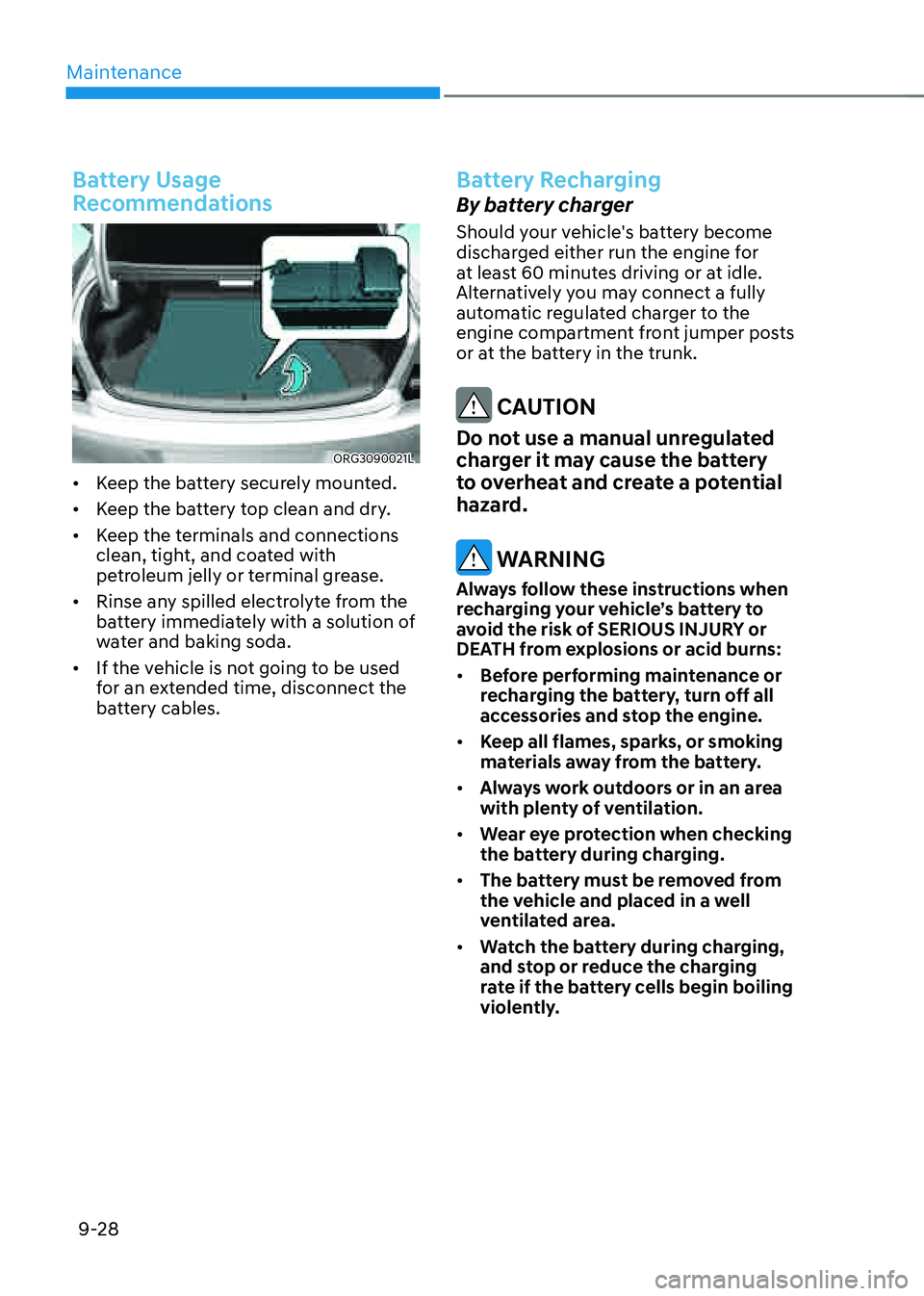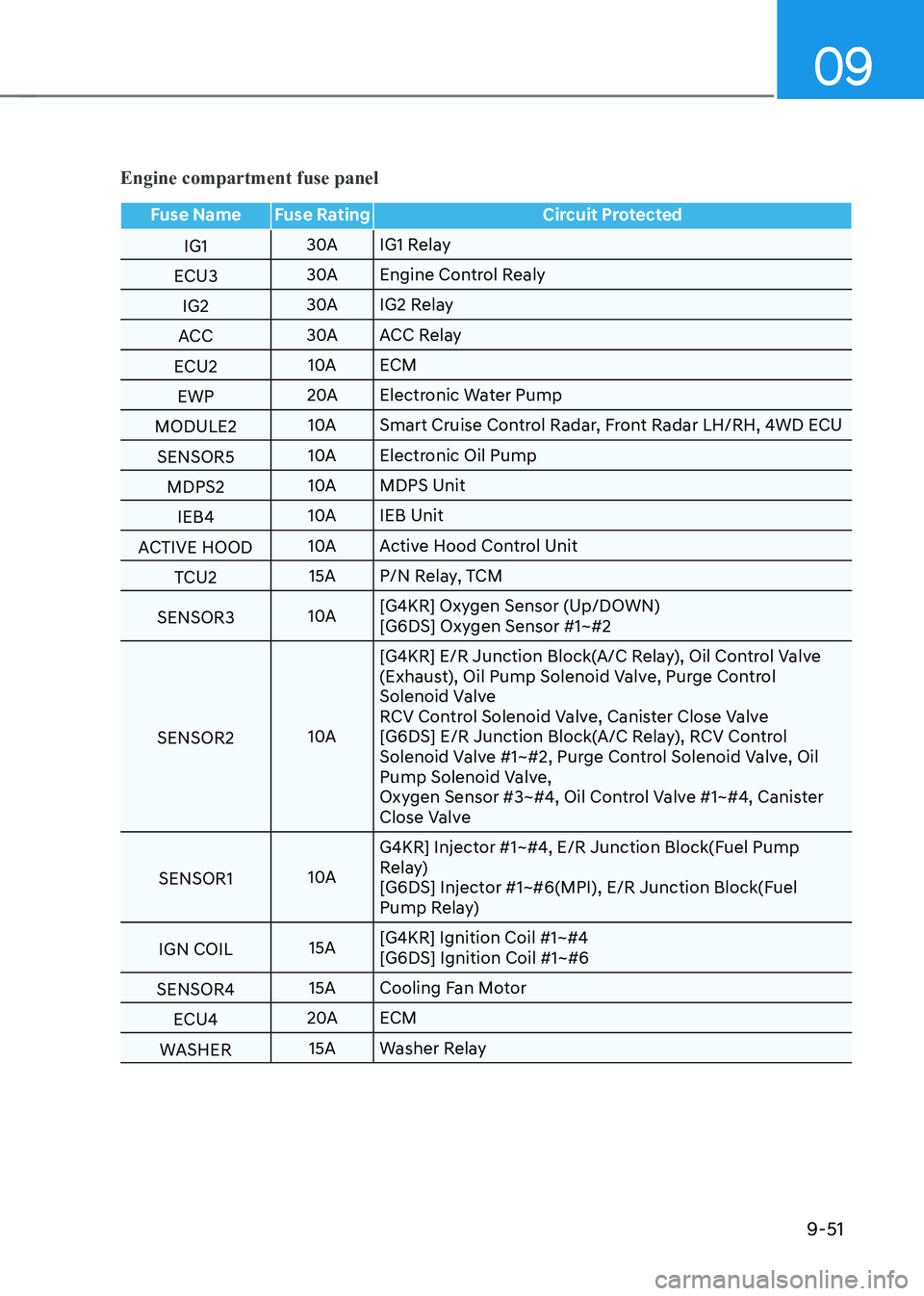ECU GENESIS G80 2021 Service Manual
[x] Cancel search | Manufacturer: GENESIS, Model Year: 2021, Model line: G80, Model: GENESIS G80 2021Pages: 604, PDF Size: 11.47 MB
Page 514 of 604

Emergency Situations
8-22
Emergency Towing
„„Front
ORG3080022
„„Rear
ORG3080019
If towing is necessary, we recommend
you have it done by an authorized
retailer of Genesis Branded products or a
commercial tow truck service.
If towing service is not available in
an emergency, your vehicle may be
temporarily towed using a cable or chain
secured to the emergency towing hook
at the front (or rear) of the vehicle.
Use extreme caution when towing the
vehicle with a cable or chain. A driver
must be in the vehicle to steer it and
operate the brakes.
Towing in this manner may be done
only on hard-surfaced roads for a short
distance and at low speeds. Also, the
wheels, axles, power train, steering
and brakes must all be in good working
condition.
CAUTION
The driver must be in the vehicle for
steering and braking operations when
the vehicle is being towed. Passengers
other than the driver must not be in the
vehicle.
Always follow these emergency towing
precautions:
• Press the Engine Start/Stop button
to the ACC position so the steering
wheel is not locked.
• Shift the gear to N (Neutral).
• Release the parking brake.
• Depress the brake pedal with more
force than normal as you will have
reduced braking performance.
• More steering effort will be required
because the power steering system
will be disabled.
• Use a vehicle heavier than your own to
tow your vehicle.
• The drivers of both vehicles should
communicate with each other
frequently.
• Before emergency towing, check that
the hook is not broken or damaged.
• Fasten the towing cable or chain
securely to the hook.
• Do not jerk the hook. Apply steady
and even force.
Page 534 of 604

09
9-19
WARNING
Never remove the engine coolant radiator cap, coolant
cap or the drain plug while
the engine and radiator are
hot. Hot coolant and steam
may blow out under pressure,
causing serious injury.
Turn the vehicle off and wait until
the engine cools down. Use extreme
care when removing the radiator cap,
coolant cap. Wrap a thick towel around
it, and turn it counterclockwise slowly
to the first stop. Step back while the
pressure is released from the cooling
system. When you are sure all the
pressure has been released, press down
on the cap, using a thick towel, and
continue turning counterclockwise to
remove it.
Information
The coolant level is influenced by the
engine temperature. Before checking or
refilling the coolant, turn the engine off.
WARNING
The electric motor for the cooling fan may continue to
operate or start up when the
engine is not running and can
cause serious injury. Keep
hands, clothing and tools away
from the rotating fan blades of
the cooling fan.
Always turn off the vehicle unless the
vehicle has to be inspected with the
engine on. Be cautious as the cooling
fan may operate if the negative (-)
battery terminal is not disconnected.
WARNING
Make sure the coolant cap is properly
closed after refilling coolant. Otherwise
the engine could be overheated while
driving.
„„Engine compartment front view
OOSH089010L
1. Check if the coolant cap label is
straight in front.
OJX1099046
2. Make sure that the tiny protrusions
inside the coolant cap is securely
interlocked.
Page 543 of 604

Maintenance
9-28
Battery Usage
Recommendations
ORG3090021L
• Keep the battery securely mounted.
• Keep the battery top clean and dry.
• Keep the terminals and connections
clean, tight, and coated with
petroleum jelly or terminal grease.
• Rinse any spilled electrolyte from the
battery immediately with a solution of
water and baking soda.
• If the vehicle is not going to be used
for an extended time, disconnect the
battery cables.
Battery Recharging
By battery charger
Should your vehicle's battery become
discharged either run the engine for
at least 60 minutes driving or at idle.
Alternatively you may connect a fully
automatic regulated charger to the
engine compartment front jumper posts
or at the battery in the trunk.
CAUTION
Do not use a manual unregulated
charger it may cause the battery
to overheat and create a potential
hazard.
WARNING
Always follow these instructions when
recharging your vehicle’s battery to
avoid the risk of SERIOUS INJURY or
DEATH from explosions or acid burns:
• Before performing maintenance or
recharging the battery, turn off all
accessories and stop the engine.
• Keep all flames, sparks, or smoking
materials away from the battery.
• Always work outdoors or in an area
with plenty of ventilation.
• Wear eye protection when checking
the battery during charging.
• The battery must be removed from
the vehicle and placed in a well
ventilated area.
• Watch the battery during charging,
and stop or reduce the charging
rate if the battery cells begin boiling
violently.
Page 560 of 604

09
9-45
Engine Compartment Panel Fuse
Replacement
Blade fuse / Cartridge fuse
„„Blade type fuse
ORG3090026
„„Cartridge type fuse
ORG3090027
1. Turn the vehicle off.
2. Turn all other switches off.
3. Remove the fuse panel cover by
pressing the tap and pulling up.
4. Check the removed fuse; replace it
if it is blown. To remove or insert the
fuse, use the fuse puller in the engine
compartment fuse panel.
5. Push in a new fuse of the same
rating, and make sure it fits tightly in
the clips. If it fits loosely, consult an
authorized retailer of Genesis Branded
products.
NOTICE
After checking the fuse panel in the
engine compartment, securely install
the fuse panel cover. You may hear a
clicking sound if the cover is securely
latched. If it is not securely latched,
electrical failure may occur from water
contact.
Multi fuse / Midi fuse
„„Multi type
ORG3090028
„„Midi type
ORG3090029
If the multi fuse or midi fuse is blown,
consult an authorized retailer of Genesis
Branded products.
Page 562 of 604

09
9-47
Instrument panel fuse panel
Fuse NameFuse Rating Circuit Protected
MODULE9 10AOverhead Console, AMP, Smart Phone Wireless Charger,
Low DC-DC Converter (AUX/AMP), Data Link Connector,
Driver/Passenger Power Seat Module, Electro Chromic
Mirror, Front/Rear A/C controller, Rear Seat Console
Remote Control Switch Switch, A/V & Navigation Head
Unit, A/C Control Module, Rear Seat LH/RH Heater Unit
SUNROOF 25A
Sunroof Control Unit (Master/Slave)
MODULE11 10AHead Lamp LH, Head Lamp RH, Multifunction Switch,
ADAS Unit (Parking)
MODULE12 10A
IAU, IBU
A/C3 10AE/R SUB Junction Block(Blower Relay), Incar Temperature
Sensor, A/C Control Module, Front A/C controller, Rear A/C
controller
A/BAG IND 10A
Instrument Cluster, Overhead Console
E-SHIFTER2 10A
Electronic ATM Shift Lever Dial
SPARE(IG2) 10A
Not Used
MODULE10 10A
ICU Junction Block (ESU)
MODULE7 10ADriver Door Module, IBU, Multifunction Switch, IAU, Stop
Lamp Switch
MULTI MEDIA 10A
Low DC-DC Converter
MODULE13 10AFront/Rear A/C controller, Rain Sensor, Head-Up Display,
Security Indicator, A/C Control Module, Rear Occupant
Alert (ROA) Sensor, PTL Unit, Driver/Passenger Power
Outside Mirror, Driver/Passenger Power Seat Module,
Driver/Passenger Power Seat Switch, Driver/Passenger
Lumbar Support Unit(3/5/7CELL)
CLUSTER 10A
Instrument Cluster, Head-Up Display
IBU2 10A
IBU
AIR BAG2 15A
SRS Control Module, Passenger Occupant Detection Sensor
PRESAFETY
SEAT BELT3 10A
Pre-Active Seat Belt Unit
Page 565 of 604

Maintenance
9-50
Engine compartment fuse panel
TypeFuse Name Fuse Rating Circuit Protected
MAIN A LT
225A
Alternator
MDPS1 125A
MDPS Unit
MULTI COOLING FAN
100A
Cooling Fan Motor
GLOW 100A
Not Used
IEB1 60A
IEB Unit
IEB2 60A
IEB Unit
OIL PUMP 50A
Electronic Oil Pump
IEB3 50A
IEB Unit
REAR HEATED 40A
Rear Heated Relay
E-CVVT1 40A
E-CVVT Relay
4WD 30A
4WD ECU
WIPER 30A
Wiper Motor
SB HEAD LAMP LH
30A
Head Lamp LH
START 30A
Start Relay
HEAD LAMP RH 30A
Head Lamp RH
MICRO A/C
15A
A/C Relay
HORN 15A
PCB Block(Horn Relay)
HTD IND 10A
Front A/C controller
E-CVVT2 20A
ECM
E-CVVT3 20A
ECM
MODULE1 10A
Not Used
FUEL PUMP 20A
Fuel Pump Relay
ECU1 15A
ECM
TCU1 20A
TCM
Page 566 of 604

09
9-51
Engine compartment fuse panel
Fuse NameFuse Rating Circuit Protected
IG1 30A
IG1 Relay
ECU3 30A
Engine Control Realy
IG2 30A
IG2 Relay
ACC 30A
ACC Relay
ECU2 10A
ECM
EWP 20A
Electronic Water Pump
MODULE2 10A
Smart Cruise Control Radar, Front Radar LH/RH, 4WD ECU
SENSOR5 10A
Electronic Oil Pump
MDPS2 10A
MDPS Unit
IEB4 10A
IEB Unit
ACTIVE HOOD 10A
Active Hood Control Unit
TCU2 15A
P/N Relay, TCM
SENSOR3 10A[G4KR] Oxygen Sensor (Up/DOWN)
[G6DS] Oxygen Sensor #1~#2
SENSOR2 10A[G4KR] E/R Junction Block(A/C Relay), Oil Control Valve
(Exhaust), Oil Pump Solenoid Valve, Purge Control
Solenoid Valve
RCV Control Solenoid Valve, Canister Close Valve
[G6DS] E/R Junction Block(A/C Relay), RCV Control
Solenoid Valve #1~#2, Purge Control Solenoid Valve, Oil
Pump Solenoid Valve,
Oxygen Sensor #3~#4, Oil Control Valve #1~#4, Canister
Close Valve
SENSOR1 10AG4KR] Injector #1~#4, E/R Junction Block(Fuel Pump
Relay)
[G6DS] Injector #1~#6(MPI), E/R Junction Block(Fuel
Pump Relay)
IGN COIL 15A[G4KR] Ignition Coil #1~#4
[G6DS] Ignition Coil #1~#6
SENSOR4 15A
Cooling Fan Motor
ECU4 20A
ECM
WASHER 15A
Washer Relay